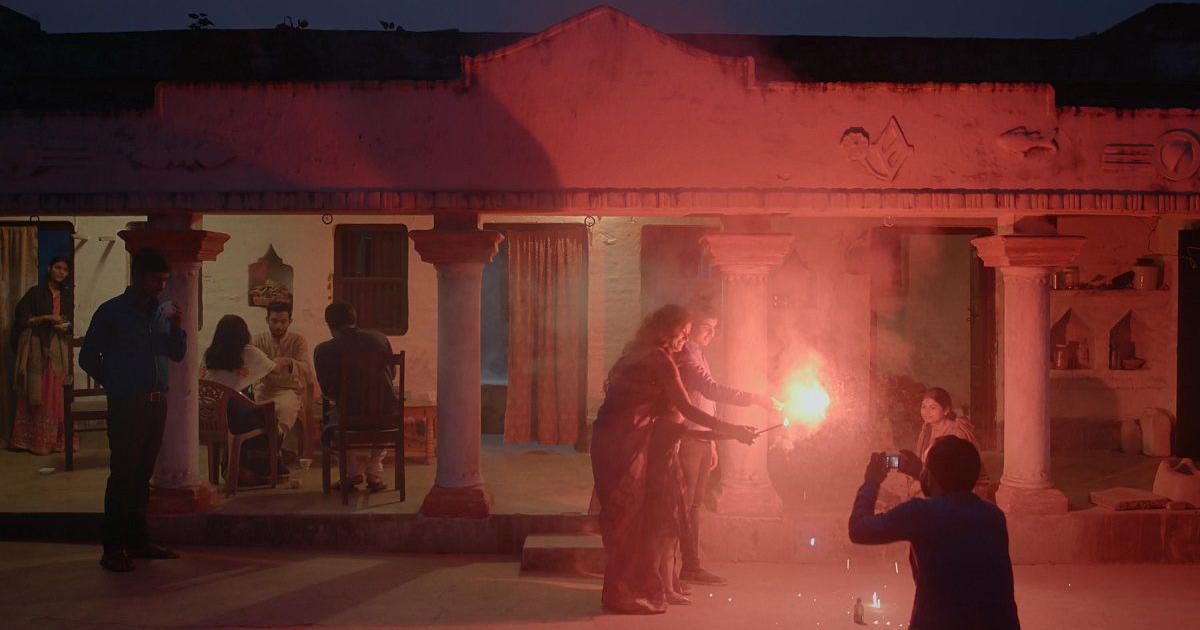Traditions don’t disappear overnight. They slip away slowly over decades, as elders die off and younger generations experience shifts in priority, social norms, and cultural pride. Few films have been able to capture this kind of ebb and flow like Achal Mishra’s Gamak Ghar, a quietly beautiful drama primarily set in the rural compound where one Indian clan gathers for major life events. Split into three separate chapters that take place years apart, the film shows a graceful appreciation for the small decisions and compromises that eventually add up to profound change inside a family dynamic.
The first vignette, shot in Academy ratio and set in 1998, opens with a hazy still countryside image worthy of Kiarostami. A winding dirt road passes the vista’s lone tree, which is flanked by an ocean of short grass staring up at billowing white clouds and hazy blue sky. We’d half expect someone to pass on a puttering motorbike. Instead, the film gives us a tenderly composed score meant to conjure up fond memories of old.
Those musical notes drift in and out of multiple scenes establishing the perimeter and interiors of an expansive house where family members gather to celebrate the birth of a new baby boy. Older men chat idly and play games of chance, while children play tag and laugh in the open-air courtyard. Inside, the women do most of the work preparing food for the feast to come.
Mishra doesn’t center the narrative around one central character, freeing the film from fixating on any of the archetypal conflicts found in most family dramas. Instead, the house itself becomes a core presence, providing a background to the social responsibilities tied to each group, and spaces for eavesdropping on gossipy conversations with plenty of subtext. Still, there’s so much life and bustling energy in every frame, helping to create the collective fabric of family lore.
While the aspect ratio expands to widescreen in Gamak Ghar’s second chapter (set in 2010), it feels altogether closed-off, emptier and colder. Another celebration has arrived, but there are far fewer attendees, and now that the younger generation is in charge, much of the dutiful attention to detail has been replaced by well-meaning pastiche. Characters have less time to chat with each other, and feel increasingly stressed by the rituals that once seemed so effortless and vital.
As two relatives discuss the reasons why these changes might be occurring, one says, “There’s no time these days.” But the house itself has had plenty of years to become increasingly downtrodden, its once white pillars now discolored. Leafy vines that used to climb up the façade have withered away. Most shocking though is the sobering quiet, the absence of adults chatting and children laughing.
Strikingly, the last segment of Gamak Ghar, which takes place in 2019, almost completely strips away the presence of human beings altogether. Only a groundskeeper can be seen walking the desolate grounds where furnished rooms once stood as blankets of fog roll through the yard.
Here, the severed ties between past and present become potently stark. Like master filmmakers Edward Yang and Hou Hsiao-hsien, Mishra understands how cinematic aesthetics can beautifully mirror the invisible momentum of time. Yet, in the case of Gamak Ghar, there’s less revelation than a twinge of disappointment at something lost forever. In the film’s stunningly slow fade to black, laborers renovate the old roof for the next wave of family occasions. But the bitter truth is that sunlight from above will never hit this place in quite the same way again, no matter how much the next generation or occupants chooses to think differently.
Gamak Ghar is playing at the San Diego Asian Film Festival.

